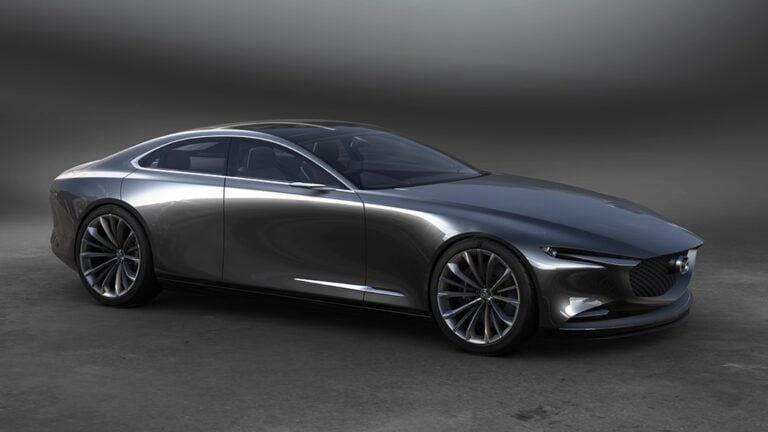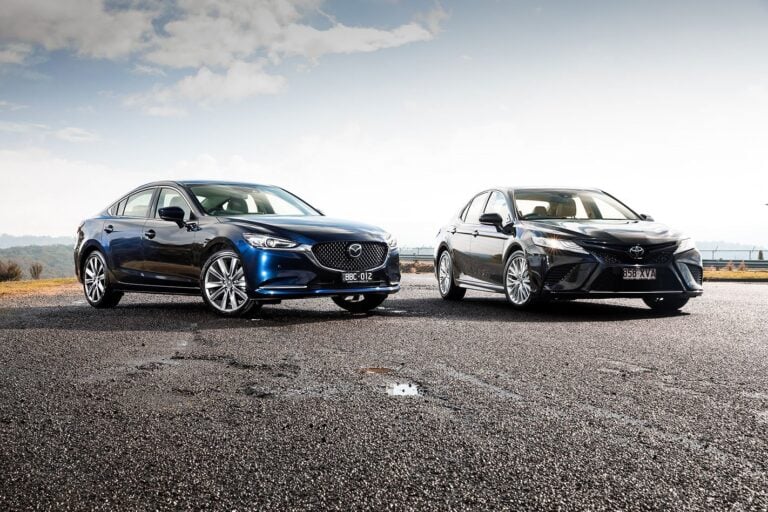Score breakdown
Things we like
- Quality interior finish
- Solid sound system
- Compliant ride
Not so much
- Underpowered engine
- Average turning circle
- Intrusive lane departure warning
The Mazda 6 has long been a staple of the medium-sized sedan market, recently locked into a battle for second place with the Skoda Octavia while the Toyota Camry continues to have the momentum of a runaway freight train.
Despite being underpinned by a chassis that is coming up on a decade in production, continual refinements to the Mazda 6 have helped it remain competitive against its European and Asian rivals.
For a week, the Mazda 6 Sport sedan replaced my own Octavia and was given a shakedown around Brisbane to see if the Japanese manufacturer still has a product to fight with, or whether the next-generation model should be brought forward to replace it.
Pricing

Available in any one of four flavours, the Mazda 6 range can be purchased as a four-door sedan or five-door wagon with a variety of eight colours to choose from, three of which come with a $495 price tag.
In sedan guise, the 6 is $1300 cheaper than the longroof, starting at $34,590 before on-road costs for the entry-level Sport four-door. Moving up to the Touring will bump that figure up to $38,890, followed by $46,690 for the GT SP before topping out at $50,090 for the range-topping Atenza (all before on-roads).
On test is the Sport, finished in Deep Crystal Blue Mica (my pick of the colour palette) with the optional $246.46 floor mats, the only non-standard feature I could pick out. All up, Mazda’s website calculates this spec 6 would set buyers back $38,618 drive-away, keeping it under the $40K mark.
Features

Facelifts and upgrades throughout the third-generation 6’s lifecycle have allowed it to stay relevant in a competitive segment, although as previously mentioned, its sales of 1408 units to the end of November are dwarfed by the Toyota Camry, which in a single month can nudge the Mazda’s year-to-date result.
With its last exterior facelift coming in 2018, the 6 is starting to look a tad dated but not yet out of date, helped in part by the abundance of chrome surrounding the grille and other highlights.
If there’s one reason to upgrade from the Sport variant, it is the wheels – while the 17-inch alloys and 225/55 tyres are indeed a comfortable and quiet combination, they look small in the arches, seemingly tempting buyers to step up a grade for a slightly more well-rounded look.

Mazda seems to have left an 18-inch size hole in its line-up, as the Sport and Touring are only available with 17-inch wheels while the GT SP and Atenza go straight up to 19s, shod in 225/45 rubber.
The side and rear styling is nothing exciting but far from offensive, while the single exhaust outlets on either side of the bumper provide symmetry where other models in the segment tend to play the easy game with a single exit.
At 4865mm in length, the 6 just scrapes into what can be deemed as a medium-size car these days, although the Euro-oriented wagon actually measures up 65mm shorter thanks to its 2750mm wheelbase, a decent chop from the sedan’s 2830mm.

Width remains identical for both bodies at 1840mm, while their heights stand at 1450mm in sedan guise and 1480mm for the wagon, resulting in kerb weights of 1539kg and 1555kg respectively.
Boot space is ample in the sedan at 474 litres when the back seats are up, however, this is less than the Camry (524L) and Octavia liftback (600L).
For the long-roof 6, boot capacity is raised to 506 litres when the second row of seats are up, increasing to a generous 1648 litres when folded down, second only to the Octavia wagon by 52 litres.
The standard key is a relatively flat unit with the three buttons positioned on its side, creating a lot of awkward pocket-fumbling situations that ultimately end up in pulling it out to check the right button has been pressed.
Annoyingly, this entry-level 6 doesn’t have touch-sensitive door locks (keyless entry is standard from Touring grade and up), something I discovered when carrying a relatively heavy bag of shopping that was slipping out of my hands. While it’s a first-world problem, having to set things down rather than just walk up to the car is a bit frustrating.

Stepping inside the cabin, any concerns about the base model being a cheap, no-frills option are quickly put to rest. Surfaces are soft to the touch and it’s nearly impossible to find any hard plastics, giving the occupants a premium feel for a cut-price cost.
Otherwise, being behind the wheel is a pretty nice place to be, and an abundance of tech makes it more relaxing.
Standard across the race is wired Apple CarPlay and Android Auto, with which there were no issues in terms of operation – although it would be nice if Mazda could introduce wireless operations to truly get a leg up on its competitors.
Despite coming up on a decade in production, Mazda has made continual refinements to help the 6 to remain competitive against its European and Asian rivals.

The 8.0-inch infotainment screen is easy enough to navigate with either the control dial on the console or through touch inputs when stationary, with the usual host of USB/Bluetooth/DAB+ digital radio available on top of the Apple and Android systems and pumped through a very impressive six-speaker system.
Even though the tech up front is up to date, a lack of rear USB ports leaves that extra little touch to be desired, making rear passengers fight for one of the front chargers.
A head-up display with speed limit sign recognition is a far handier tool than I expected it to be, especially driving through unfamiliar suburbs, but one drawback – common across similar systems – is an inability to integrate with mapping apps when using smartphone mirroring rather than the native sat-nav interface.
I should clarify there’s nothing wrong with the standard Mazda navigation system, it’s just that phone apps tend to be better at keeping you aware of delays on the road.
Going from car to car as we do in this business, it’s sometimes hard to get your head around certain steering wheel layouts but the 6’s is intuitive, with cruise control easy to find, activate and set to sit as close behind the car in front as it allows.
Comfort and space

As someone of average build and six feet tall, there is enough room in the Mazda 6 no matter what seat I position myself in. Even after enlisting the help of a much taller friend, we could set the driver’s seat to his position then sit in the back with enough room to stretch out, while ISOFIX points in the rear means the kids will be safely locked in.
While I personally haven’t sat in the leather-appointed seats of higher grades, it took a few days and far too many manual adjustments to get the driver’s seat to a position I was totally comfortable in, mainly due to an excess of lumbar support even in its lowest setting.
Another problem arose when cornering in the 6 due to the lack of side support on the seat, forcing me to brace myself a little more than anticipated – I know it’s not a performance car but when it rolls through a corner, it would be nice to at least be supported from the position of control.

Realistically, the only issues I had were with the seat, although some would argue it’s the most important part as you can’t operate the car without it. A more useable armrest on top of the centre console would’ve been a nice touch but maybe that’s for the next generation.
The 60:40 split rear seats can be folded using either the tabs just next to the outer headrests or two handy levers in the boot, although pulling these still requires you to open the rear doors to totally fold the seatbacks.
As someone who is six feet tall, there is enough room in the Mazda 6 no matter what seat I position myself in.
On the road

Up here in the affordable parts of Brisbane, there are a few different road surfaces to contend with; smooth, bumpy and unloved. Across all three, there were no complaints from myself or passengers while travelling in the Mazda 6, even from bumps which I’m used to avoiding totally.
With a pass on the local roads, a few runs on the M1 reiterated this would be a very solid highway cruiser for families, soaking up the bumps and really feeling eerily smooth, as the steering and throttle inputs seem to be optimised to driving on motorways.

Despite being a mid-size sedan with over a tonne and a half of weight to lug around, the Mazda 6’s “Sport” tag does well to live up to its name considering the rest of the market, handling better than its competitors in the segment.
However, give it a bit too much and you start to feel the comfort-focused suspension starting to wonder if you’ve asked a bit too much of it, with body roll starting to come to the fore, encouraging you to dial it back a bit.
If there’s one upshot to this characteristic, it is at least linear in how it flows through a corner, with no real weight transfer issues arising when going on- or off-throttle.

However, you often do have a bit of time to think about how to set up a corner on account of the base engine in the Sport and Touring grades.
Under the bonnet of the two variants is Mazda’s 2.5-litre, four-cylinder engine. It pushes out 140kW at 6000rpm and 252Nm at 4000rpm, resulting in a power to weight ratio of 93.3kW/tonne.
While this power is identical to the similarly priced Skoda Octavia 140TSI Limited Edition, the Czech car pushes out 320Nm between 1500-4180rpm thanks to its turbocharger and its power to weight ratio is a superior 99.6kW/tonne.
Although the engine delivers enough to move the Mazda 6, there are times when more power is desired, such as merging on the rarely fast-flowing M1 when traffic is moving at 100km/h.

If you want a bit more oomph from your 6, the GT SP and Atenza gain a turbo to bump outputs up to 170kW at 5000rpm and 420Nm at 2000rpm, a considerable jump over the naturally aspirated unit for a healthier 107.9kW/tonne.
No matter which engine you choose, drive is exclusively sent to the front wheels through a conventional six-speed torque-converter automatic – a pleasant departure from the all-too-common CVTs.
Unfortunately, I think I’d enjoy the stronger donk a fair bit more than the entry-level unit, as you really start to feel the weight of the car when trying to drag it up to speed and I daren’t try any overtakes on country roads because there just might not be enough space to get the job done.

Fuel economy on the combined cycle is rated at 7.0L/100km but I was unable to properly test this as the tank barely went down by a quarter over the seven days it was in my possession, although after some city and vigorous driving the trip computer reported 9.0L/100km.
With a 62-litre fuel tank fitted to all variants, achieving around 800km of range between fills is theoretically possible, especially on high-speed highway runs.
A few runs on the M1 reiterated this would be a very solid highway cruiser for families, soaking up the bumps and feeling eerily smooth.
Safety

Standard across the Mazda 6 range are a host of safety features, including:
- Blind-spot monitoring
- Driver attention alert
- High beam control
- Intelligent speed assistance
- Lane departure warning
- Lane-keep assist
- Adaptive cruise control with stop and go function
- Parking sensors (rear)
- Rear cross-traffic alert
- Auto-dimming rear-view mirror
- Reversing camera
- Smart brake support
- Smart city brake support
- Traffic sign recognition
- Tyre pressure monitoring system
Within five minutes of picking the car up, I had located and disengaged the lane departure warning and lane-keep assist systems, both of which proved to be far too intrusive around the arterial roads. Although a handy feature on the highway, around town it was nothing but frustrating.

The adaptive cruise was intelligent and left consistent gaps, although the underpowered engine sometimes struggles to keep the spaces as tight as I wanted, especially when some of the more aggressive drivers on the road want to make use of every available spot
A lack of front parking sensors is a bit of a shame, although it acts as another incentive to step up to a higher grade. With a relatively tight car space where I live, I found myself backing the car in rather than going nose-first – not my preferred style but with the relatively long bonnet, it was the safest option.
Last tested in 2018, the Mazda 6 range retains its five-star ANCAP safety rating, having fared particularly well in the adult and child occupant protection tests (95 and 91 per cent respectively) but losing a lot of marks for its pedestrian protection, with a score of only 66 per cent.
Ownership

As with the rest of the Mazda range, the 6 is covered by a five-year/unlimited-kilometre warranty, throwing in complementary premium roadside assistance for the period to sweeten the deal.
Mazda’s capped-price servicing is also applicable to the 6, covering the first five services at intervals of 12 months/10,000km, whichever comes first.
Pricing for these services alternates between $337 for the first, third and fifth service while the second and fourth are $30 more, contributing to a total capped-price service cost of $1745 over the five-year period.
VERDICT

Better suited to highways than city streets, it’s the kind of car that would be perfect for a two-adult, two-child family that does regular interstate travel, with the boot providing decent space for luggage and equipment while those who need more flexibility have the wagon option.
I understand why the Sport and other base variants across many models exist but I would personally spend a bit more coin to move up the food chain, although going high enough to get that desirable turbo engine does come at a significant $12,000+ premium over the Sport.

At that sort of money, you’re almost into the territory of Skoda’s Octavia RS – but some may not want to deal with the dual-clutch gearbox or significantly firmer ride.
Still, the Mazda 6 seems like good value and there’s certainly still a market there for it, but its next generation (which is rumoured to switch to a rear-drive platform with powerful six-cylinder engines) will need to do some pretty special things if it wants to de-throne the Camry.
Flashback
2021 Mazda 6 Sport specifications
Score breakdown
Things we like
- Quality interior finish
- Solid sound system
- Compliant ride
Not so much
- Underpowered engine
- Average turning circle
- Intrusive lane departure warning
We recommend
-
 News
NewsRear-driven Mazda sedan with six-cylinder engine set for 2022 debut
Mazda will introduce the company’s first rear-wheel-drive sedan in 25 years
-
 Features
FeaturesMazda 6 MPS: Sweet Dream
War wagon the perfect platform for a brand revival
-
 Comparisons
ComparisonsMazda 6 GT vs Toyota Camry SL V6 Comparison
Mazda’s new turbo 2.5-litre four takes on Toyota’s big-boy V6






